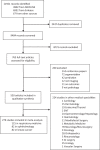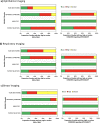Diagnostic accuracy of deep learning in medical imaging: a systematic review and meta-analysis
- PMID: 33828217
- PMCID: PMC8027892
- DOI: 10.1038/s41746-021-00438-z
Diagnostic accuracy of deep learning in medical imaging: a systematic review and meta-analysis
Abstract
Deep learning (DL) has the potential to transform medical diagnostics. However, the diagnostic accuracy of DL is uncertain. Our aim was to evaluate the diagnostic accuracy of DL algorithms to identify pathology in medical imaging. Searches were conducted in Medline and EMBASE up to January 2020. We identified 11,921 studies, of which 503 were included in the systematic review. Eighty-two studies in ophthalmology, 82 in breast disease and 115 in respiratory disease were included for meta-analysis. Two hundred twenty-four studies in other specialities were included for qualitative review. Peer-reviewed studies that reported on the diagnostic accuracy of DL algorithms to identify pathology using medical imaging were included. Primary outcomes were measures of diagnostic accuracy, study design and reporting standards in the literature. Estimates were pooled using random-effects meta-analysis. In ophthalmology, AUC's ranged between 0.933 and 1 for diagnosing diabetic retinopathy, age-related macular degeneration and glaucoma on retinal fundus photographs and optical coherence tomography. In respiratory imaging, AUC's ranged between 0.864 and 0.937 for diagnosing lung nodules or lung cancer on chest X-ray or CT scan. For breast imaging, AUC's ranged between 0.868 and 0.909 for diagnosing breast cancer on mammogram, ultrasound, MRI and digital breast tomosynthesis. Heterogeneity was high between studies and extensive variation in methodology, terminology and outcome measures was noted. This can lead to an overestimation of the diagnostic accuracy of DL algorithms on medical imaging. There is an immediate need for the development of artificial intelligence-specific EQUATOR guidelines, particularly STARD, in order to provide guidance around key issues in this field.
Conflict of interest statement
D.K. and A.K. are employees of Google Health. A.D. is an adviser at Google Health. D.S.W.T holds a patent on a deep learning system for the detection of retinal diseases.
Figures


References
Publication types
Grants and funding
LinkOut - more resources
Full Text Sources
Other Literature Sources

